AFTER THE TIBETAN UPRISING IN 2008
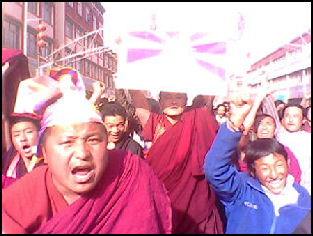
monks protesting at Labrang As of April, about 80 percent of the businesses closed after the uprising had opened. There were sporadic reports of weapons being found in Tibetan temples and monasteries; Tibetan air passengers being detained for “suspicious remarks” on flights forced ot return their departure points; and offers for information leading to the arrest of troublemakers.
Beijiing announced it was planning to open Tibet to tourists in May 2008 then, a week later, reversed itself, saying the torch relay up Everest had to be protected. . . Shops, hotels, restaurant and tour operators complained about hardships and losses due to the region being closed to tourists.
A month after the protest China was strengthening its clampdown in Tibet and Tibetan areas. In Aba district and Qiang Autonomous Prefecture in Sichuan and Gannan Tibetan Autonomous Prefecture in Gansu province there were reports of spot checks for Dalai Lama images; monks being forced to sign anti-independence statements and attend lecture that stressed the need for “unification of the home country"; and a heavy military presence of the streets, with new convoys with security forces and supplies arriving all the time. Aba and other troubled areas were closed to journalists.
One man in a county close to Aba county told the Yomirui Shimbin, ‘since the rioting in Lhasa, policemen have begun calling at houses out of the blue and searching for photographs of the Dalai Lama. Police are now also checking people’s belongings in the street. Many people used to discreetly hang photos of the Dalai Lama on their walls, or carry them in pendants, but we don’t any more."
The Dalai Lama’s birthplace in Qinghai Province was overrun with security forces and placed under virtual lock-down. Relatives were effectively placed under house arrest. Movement outside was strictly limited, A notice pinned on the gate of the Dalai Lama’s childhood home prohibited all “destructive and anti-government behavior.” Dreprung and Sera monasteries in Lhasa reopened in late April. A spokesman for the government said, “Monks have been taught legal knowledge in recent days and the monastery has resumed normal religious activities. Jokhang temple opened in mid May, two months after the riot. In July 2008, three months after the riots, Tibet was reopened to foreign tourists. Drepung monastery reopened in August 2008.
See Separate Articles: TIBET IN THE 1980s, 1990s AND 2000s factsanddetails.com ; TIBETAN UPRISING AND RIOTS IN 2008 factsanddetails.com ; PROTESTS AND VIOLENCE IN TIBET AFTER THE 2008 RIOTS factsanddetails.com ; SELF-IMMOLATIONS IN TIBET factsanddetails.com ; REACTIONS TO THE SELF- IMMOLATIONS IN TIBET AND BEIJING'S EFFORTS TO STOP THEM factsanddetails.com ; CHINESE POLICY TOWARDS IN TIBET UNDER XI JINPING factsanddetails.com RELIGIOUS REPRESSION IN TIBET factsanddetails.com
Websites and Resources
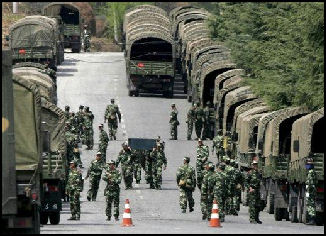
Good Websites and Sources: Tibetan Uprising.org tibetanuprising.org ; Eyewitness Accounts chineseinvancouver.blogspot.com ; Eyewitness Accounts in Christian Science Monitor csmonitor.com ; ; YouTube Video YouTube ; Photos uprisingarchive.org; Tibetan History: Tibetan History Timeline haiweitrails.com ; Friends of Tibet friends-of-tibet.org ; Wikipedia article Wikipedia ; History of Nations site historyofnations.net ; Chinese Government site on Tibetan History xinhuanet.com ; Tibet Under China: Tibet China Conflict PDF file eastwestcenter.org ; Tibet and China, Two Distinct Views rangzen.org/history : Chinese Government’s Take on Tibetan History ; index-china.com;
Links in this Website: TIBETAN HISTORY Factsanddetails.com/China ; TIBET UNDER CHINA Factsanddetails.com/China ;TIBETAN UPRISING IN 2008 Factsanddetails.com/China ; FALL OUT OF TIBETAN UPRISING IN 2008 Factsanddetails.com/China ; TIBETAN GOVERNMENT Factsanddetails.com/China ; CHINA AND TIBET Factsanddetails.com/China ; THE 2008 OLYMPICS IN BEIJING AND POLITICS Factsanddetails.com/China
Good Websites and Sources on Tibet: Central Tibetan Administration (Tibetan government in Exile) www.tibet.com ; Chinese Government Tibet website eng.tibet.cn/ Wikipedia Wikipedia Tibetan Resources; Tibetan News site phayul.com ; Open Directory dmoz.org/Regional/Asia/China/Tibet/ ; Snow Lion Publications (books on Tibet) snowlionpub.com ; Photos Tibet Photo Gallery Tibet Gallery Terra Nomada Terra Nomada ; Tibetan Cultural Sites: Conservancy for Tibetan Art and Culture tibetanculture.org ; Tibet Trip tibettrip.com ; Tibetan Cultural Region Directory kotan.org ;
Chinese Government Sources on Tibet: China Tibet Information Center en.tibet.cn ; White Paper on Tibetan Culture english.people.com.cn ; Tibet Activist Groups: Tibet Online tibet.org ; Students for a Free Tibet studentsforafreetibet.org ; Students for a Free Tibet UK /sftuk.org ; Friends of Tibet friendsoftibet.org ; Tibetan Review tibetan.review.to ; Campaign for Tibet (Save Tibet) savetibet.org ; Tibet Society tibetsociety.com ; Free Tibet freetibet.org ; Tibetan Centre for Human Rights and Democracy tchrd.org Tibetan Studies and Tibet Research: Tibetan Resources on The Web (Columbia University C.V. Starr East Asian Library ) columbia.edu ; Tibetan and Himalayan Libray thlib.org Digital Himalaya ; digitalhimalaya.com ; Tibetan Studies Maps WWW Virtual Library ciolek.com/WWWVL-TibetanStudies ; Center for Research of Tibet case.edu ; Center for Advanced Tibetan Studies amnyemachen.org ; Tibetan Studies resources blog tibetan-studies-resources.blogspot.com ; News, Electronic Journals ciolek.com/WWWVLPages
RECOMMENDED BOOKS:“Tibet's Last Stand?: The Tibetan Uprising of 2008 and China's Response” by Warren W. Smith Jr. Amazon.com; ““I Saw It with My Own Eyes”: Abuses by Chinese Security Forces in Tibet, 2008-2010" by Human Rights Watch Amazon.com; “Return to Tibet: Tibet After the Chinese Occupation” by Heinrich Harrer Amazon.com; “The Struggle for Tibet” by Wang Lixiong and Tsering Shakya Amazon.com; “Tibet: A History Between Dream and Nation-State” by Paul Christiaan Klieger Amazon.com; “Tibet on Fire: Self-Immolations Against Chinese Rule” by Tsering Woeser and Kevin Carrico Amazon.com; General History: “Tibet: A History” by Sam van Schaik Amazon.com; “A Historical Atlas of Tibet” by Karl E. Ryavec Amazon.com; “Histories of Tibet” by Kurtis R. Schaeffer , William A. McGrath, Amazon.com; “Himalaya: A Human History” by Ed Douglas, James Cameron Stewart, et al. Amazon.com; “Tibet & Its History” by Hugh Richardson (1989) Amazon.com; "Tibetan Civilization" by Rolf Alfred Stein Amazon.com; “The Story of Tibet: Conversations with the Dalai Lama” by Thomas Laird Amazon.com
Fallout of the Tibetan Uprising
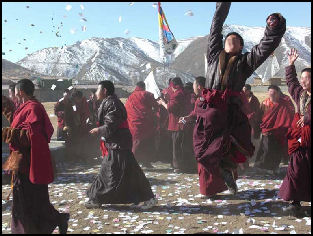
Protest in Golog
Xinhua News Agency accused the Tibetan Youth Congress of planning the riots in Lhasa. As evidence, Xinhua cited alleged statements and speeches by Youth Congress leaders, as well as a purported plot to smuggle weapons into Tibet to launch attacks. The Tibetan Youth Congress has said China's communist leadership had long sought to destroy its effectiveness by smearing its reputation. [Source: Associated Press, April 12, 2008]
In his first public comments on the protests, Chinese President Hu Jintao took a hard line on the unrest in Tibet, saying problems in the region are an internal affair that directly threatens Chinese sovereignty. "Our conflict with the Dalai clique is not an ethnic problem, not a religious problem, nor a human rights problem," Xinhua quoted Hu as saying, referring to supporters of the Dalai Lama. "It is a problem either to safeguard national unification or to split the motherland."
Pro-Tibetan, anti-Chinese protest were staged in the United States, India, Nepal, Switzerland and other places. Tibetans clashed with police outside the United Nations building in New York. Five hundred Tibetans protested outside the White House in Washington. In Kathmandu, there were several demonstrations. In one police roughed up individuals in group of around 1,000 protestors, including dozens of monks. Twelve monks were injured. In mid-April about 70 Tibetan refugees and monks in Kathmandu went on a hunger strike. Saying they would not eat until Tibetans arrested during the protests were released. In New Delhi, pro-Tibetan protesters tried to storm the Chinese embassy. There were even pro-Tibetan protest in Jakarta. Within China , there was a candlelight vigil, with 100 participants at Beijing University and a sit-in with 500 students at Northwest Nationalities University in Lanzhou, Gansu Province. Intellectuals circulated an open letter to the Communist Party on the Internet, urging them to behave in a civilized manner and hold a dialogue with the Dalai Lama.
Hannah Beech wrote in Time: Tsewang Dhondup, a trader from Kardze, fled his homeland after the 2008 unrest. Dhondup was shot while trying to help a monk who later died of bullet wounds. Wanted signs with Dhondup’s picture were posted in his village, but friends took him by stretcher high into the mountains. Maggots infested his wounds. Dhondup lived for 14 months on the edge of a glacier before escaping to India. His audience with the Dalai Lama, he says, was the most treasured moment of his life. But even he predicts that “once the Dalai Lama is gone, Tibet will explode.” [Source: Hannah Beech, Time, November 15, 2011]
Olympics and Tibetan Uprising in 2008
The Chinese government said the events in Tibet would not affect the torch realy through Tibet and to Mt. Everest nor affect the Olympics themselves. At the same time foreign governments and Tibetan groups said that the crackdown in Tibet appeared to violate Beijing’s promise to improve human rights to get the Olympics and its obligation to uphold the Olympic charter, which extols “human dignity.”
A handful of pro-Tibetan protestors disrupted the torch ceremony in Greece and managed to link the Tibetan issue and the Olympics before a worldwide media audience. In ancient Olympia, fifteen protestors, shouting “Free Tibetan” and carrying banners that read “Stop Genocide in Tibetan” charged a police cordon as the head of the Beijing Olympic Committee was giving a speech. Three men ran onto the field at the ancient stadium in Olympia during the flame-lighting ceremony, unfurling a black banner with handcuffs in shape of the Olympic rings. A Tibetan woman covered in red paint lay on a road in front of a runner carrying the Olympic torch shouting "Free Tibet” and ‘shame on China.” Chinese television, which was showing the ceremony live, cut away to a prerecorded scene,
The French foreign minster Bernard Kouchner raised the idea of boycotting the Opening Ceremony of the Olympics, an idea that was also endorsed by the president of the European Parliament. French President Nicolas Sarkozy said he might boycott the event. German Chancellor Angela Merkel, British Prime Minister Gordon Brown and Czech President Vaclav Klaus and the leaders of Poland and Estonia also said they wouldn’t attend. Sarkozy latter softened his position and called for a European-wide agreement on whether or not to boycott the Opening Ceremonies. There as some pressure of Bush to skip the ceremony but Bush insisted he would attend. Among those that came to China’s support was North Korea.
Some people who were picked to be Olympics torchbearers withdrew to protest China’s actions in Tibet. As for the sponsors that had spent millions to advertise at the Beijing games, Coca-Cola said it "joins others in expressing deep concern for the situation on the ground in Tibet....While it would be inappropriate for sponsors to comment on the political situation of individual nations....we firmly believe that the Olympics are a force of good.”
The Dalai Lama said that he would be “happy” to attend the Olympics if invited and led a special Buddhist prayer service for the victims of the Sichuan earthquake.
Olympic Torch Relay and Tibetan Uprising in 2008
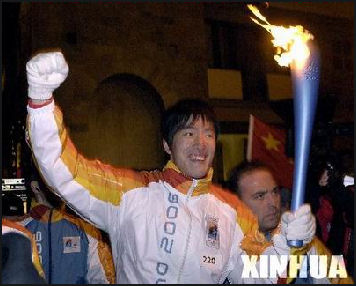
The Olympic torch relay became an object of protest. In London, police wrestled protesters to the ground who attempted to disrupt the relay. One man tried toe extinguish the flame with a fire extinguisher. In a Paris, more than 3,000 police were deployed to secure the relay route and the torch was surrounded by a phalanx of vehicles and 200 security force members, some of them on roller blades. Even with all that, the torch was put out three times and put on bus to keep it safe. At one point tear gas was used on protestors who tried to block the route. A banner with handcuffs shaped into the Olympic rings was hung from the Eiffel Tower. Even when the torch was extinguished the Olympics flame continued to burn a lantern where it is kept overnight and for plane flights.
Protesters booed the torch even as it was carried by a woman in a wheelchair, a Chinese paraolympic fencer named Jin Jing. Chinese were outraged by images of pro-Tibetan protesters trying to wrestle away the torch from her. Jin was made into a kind of hero and described on the Internet as the ‘smiling angel in a wheelchair.”
Many ordinary Chinese were again appalled that China’s Olympic moment in the spotlight was politicized. In San Francisco the relay route was shortened and a huge “Free Tibet” banner was hung from the Golden Gate Bridge. Thousands of anti-Chinese protesters, some carrying Tibetan flags and chanting ‘shame on China.” filled the streets. A planned closing ceremony was canceled and the torch was quickly placed on a plane and whisked out of the country with hardly a goodbye,
The IOC mulled stopping the international relay but Beijing insisted it go on. After the first day of trouble in London, a Chinese government spokesman said, “Today, a tiny number of Tibetan independence elements sought to disrupt the relay of the Olympic Games sacred flame....We strongly condemn this vile behavior.”
During some stops an elite unit of Chinese security officers surrounded the torch. Tall, muscular and dressed in blue-and-white running suits, they were criticized for their harshness, not only pushing away protesters but also roughing up torchbearers and people associated with the Olympics. Sebastian Coe, aan Olympic medalist and head of the London Olympics organizing committee, called them “thugs” and said they “tried tp punch me out of the way three times.” In Paris, they were the ones who put out the flames. The French described them as tense, robotic, irritable and aggressive.
The Tibetan cause is active in a number of countries and groups are fairly well organized. They were able to use their network to set up protest in a number of paces.
Dalai Lama and the Tibetan Uprising in 2008
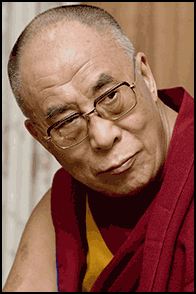
China accused the Dalai Lama of masterminding the uprising and called him a “devil with a human face.” Prime Minister Wen Jibao lashed out against him, accusing the Dalai Lama clique of trying to sabotage the Beijing Olympics and saying that Dalai Lama’s accusations of “cultural genocide” were “lies.” Wen also said, “We have plenty of evidence...proving that the incidents was organized, premeditated, masterminded and incited by the Dalai clique.”
A spokesman for the Chinese foreign ministry said. “This riot was deliberately manipulated by the Dalai Lama clique, and our government has taken legal actions to return Lhasa and other places to normality...The Dalai Lama is not purely a religious person. For a long time, he wore a religious coat and held the banner of peace while trying to separate China and destroy social stability and national unity.”
Beijing said that it had a written confession by an unidentified monk that proved the Dalai Lama incited the riots, According to an article released by Xinhua the monk said in his confession: “For the sake of protecting myself, (the Dalai Lama clique) asked me not to participate in the demonstrations in person, just in charge of stirring people up.”
On the Internet, Chinese blasted the Dalai Lama as a “terrorist jackal” and compared him to Hitler In repose to these denouncements, the Dalai Lama said, “I am really very sad the government demonize me. I am just a human, I am mot a demon."
The Dalai Lama denied the allegations made against him. He opposed a boycott of the Olympics, insisting that if nothing else the games were a chance to remind China of its human rights records and obligations. The Dalai Lama did however urge China not to conduct the torch relay in Tibet. According to spokesman for the Dalai Lama the plan “would be very deliberately provocative and very insulting after what happened.”
The Dalai Lama took both a confrontive and conciliatory stances, called for an investigation into the riots in Lhasa and repeatedly appealed to Beijing to enter into “meaningful dialogue” and said he was willing to meet Chinese leaders, including Hu Jintao. In a gesture seemingly aimed at appeasing Beijing he said the independence was “out of the question” and Tibetans must learn to live “side by side” with Chinese. At one point he threatened to “resign” if the violence escalated. “If things get too out of control,” he said, his “only option is to completely resign” — which was interpreted to mean he would step down as political leader not spiritual leader.
But at the same time the Dalai Lama called the Chinese presence in Tibet “cultural genocide” and said that Tibetans had the right to air their grievances. The Dalai Lama seemed to be as shocked as anyone by the violence and the attacks on Chinese. He said, “We must oppose Chinese police, but not the Chinese. Not on a racist basis,” But not everyone shared this view, Tsewang Rigzin, head of the Tibetan Youth Congress, “I appeal to the protestors in Tibet to continue in their protest until China gets out of Tibet.”
Chinese Take on the Events in Tibet
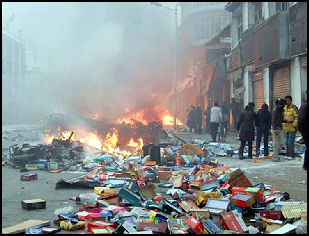
To many Chinese the riots in Lhasa were brutal, unprovoked attack on innocent Chinese. Many Chinese were upset by the way the events were covered in the foreign press: asking why sympathies were with the Tibetans when it was Han Chinese who were the victims and the ones who died. They were angry by images on television of Tibetans attacking Chinese in Lhasa and furious with police for cowering behind their shields and not fighting back.
Many ordinary Chinese supported Beijing’s hardline position on Tibet so much so that anything less than a tough crackdown in Tibet would have been perceived as weak. One 53-year-old office worker told the New York Times , “We couldn’t believe our government was being so weak and cowardly. The Dalai Lama is trying to separate China and it is not acceptable at all. We must crack down on the rioters.” On the Internet one posting read, “Our government should take a bloody suppression on these separatists!”
On the Internet some Chinese said that a “people’s war” should be mounted against the Tibetans. “People’s war” is a phrase that was used in the Cultural Revolution. What enraged many Chinese was the timing. Just as China was preparing to step in to the spotlight for its moment if glory, the Olympics, the Tibetans put a damper on things with their riots.
In April, the Chinese government said that Dalai Lama and his supporters were planning to use suicide squads to carry out attacks. According to a government spokesman, “To our knowledge, the next plan of the Tibetan independence forces is to organize “dare-to-die” corps to launch violent attacks.” The evidence was based on information revealed from an arrested member of the “Dalai Lama clique.” The Tibetan government in exile quickly dismissed the charges and insisted the Dalai Lama was a “man of peace.”
In a speech in mid April, Chinese President Hu Jintao said that the trouble in Tibet was purely an internal affair that threatens China’s sovereignty. “Our problem with the Dalai Lama clique is not an ethnic problem, not a religious problem, not a human rights problem. It is a problem either to safeguard national unification or to split the motherland.”
Analysts saw little hope of the Chinese government backing down or easing up. Rebecca MacKinnon, a professor at Hong Kong University, told the Washington Post, “The regime will go more on the offensive. Sovereignty and control is more important than international image..” The crackdown is a ‘sign to other opposition group that this is what happens to them is you make problems."
Some have argued that the response of the international community hurt the Tibetan cause more than it helped, insistimg that the reaction only stirs up nationalist and anti-Tibetan feelings among ordinary Chinese who in turn have demanded a tough response to the Tibetan problem.
Serf Emancipation Day
The 50th anniversary of the 1959 Tibetan uprising in March 2009 came and went quietly in China. Chinese security forces were out in force and had been put on alert. Foreigners were not allowed to enter Tibet for six weeks. Outside of China there were demonstrations in India, Nepal, Australia, and other places. In July 2009, a Han doctor in Lhasa told the Times of London, “Its quite safe to go into the Old Town now. There are lots of army and police there to maintain order. But better not to go out late at night.” In September 2009, on the eve of China’s 60th anniversary celebration, Beijing bared foreigners from visiting Tibet.
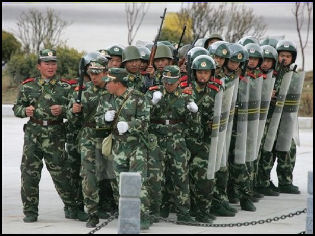
In 2009, the Chinese government created a holiday in March—“Serf Emancipation Day” — to mark the defeat of the pro-independence uprising in Tibet in 1959 and the “emancipation of millions of serfs and slaves.’serf Emancipation Day commemorates the day the Chinese Communist Party announced the creation of the Tibet Autonomous Region and dissolved the old Tibetan government on March 28, 1959. The holiday mark the date on which about one million serfs in the region were freed, Xinhua reported, adding that 90 percent of the Tibetan population in the 1950s was serfs or slaves. [Source: Edward Wong, New York Times, January 19 2009]
The bill that created the holiday stated that the creation of the Tibet Autonomous Region came after the central government foiled an armed rebellion staged by the Dalai Lama and his supporters, most of whom were slave owners attempting to maintain serfdom. That meant the end of serfdom and the abolition of the hierarchic social system characterized by theocracy, with the Dalai Lama as the core of the leadership, Xinhua added.
In conjunction with the new holiday, Tibetans in fur hats and traditional costumes performed dances and the government handed out literature that highlighted all the great things China had done to make Tibet a safer an more prosperous place, held an exhibition showing the horrors that occurred when the Dalai Lama was in control and ran polemic articles in Tibetan newspapers with with titles like “From serfs to masters of the country.”
Chinese officials said 13,000 people in Lhasa celebrated Saturday, the anniversary of the day China took control of Tibet and forced its spiritual leader, the Dalai Lama, into exile. The state-run media posted photographs of smiling Tibetans playing tug of war and other games in commemoration of what the Chinese government terms Serf Emancipation Day. [Source: Sharon Lafraniere, New York Times, March 30, 2009]
China's Tibet Exhibit
An exhibit on on Tibet at the Cultural Palace of Nationalities in 2009 to commemorate the 50th Anniversary of Democratic Reforms in Tibet — and held a year after the riots in Lhasa — featured display cases of gruesome torture devices, grainy film scenes of mutilated faces and the liberation shots of beaming Tibetans. Soldiers, schoolchildren and government officials were bused in day after day to check it out. [Source: Andrew Jacobs, New York Times, March 12, 2009]
Andrew Jacobs wrote in the New York Times, “The exhibit also tried to drive home the government’s long-held claim that the Dalai Lama is stoking separatist sentiment among an otherwise contented populace. The Restoration Fantasy of the Dalai Clique is how one panel introduces evidence purporting to show that the Dalai Lama, backed by foreign powers and Western journalists, is seeking a return to power and to tear China apart.”
The exhibit, entitled "Tibet: Past and Present" was divided into two parts: the first, called "The History of Tibet and Feudal Serfdom in Old Tibet" featured images of peasants maimed and crippled by lords and Buddhist lamas; the second, "New Tibet Changing With each Passing Day" showed modern Tibet in all its glory. One highlight was a life-size diorama of gleeful Tibetans tossing feudal documents into a bonfire.
The exhibit claimed that during 50 years of development, Tibet has moved from darkness to light, poverty to affluence, dictatorship to democracy, and seclusion to opening up. Dai Zhirong, an electronics salesman from Tianjin, told the New York Times that what he saw only reaffirmed his disgust for the Dalai Lama and his disappointment with the Tibetan people. “I don’t understand how they can eat our food and still hate us." [Op Cit, Jacobs]
Arrests After Tibetan Riots
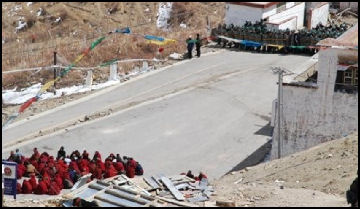
police and monks
face off at Ganden
As of February 2009, 76 people had been sentenced and 950 had been detained since the March 2008 riots in Tibet, according to Xinhua, which attributed the sentencing and arrest figures to Nyima Tsering, the deputy head of the regional parliament, but gave no details of alleged offenses, sentences or the detainees' fate. As of June 2008, 42 Tibetans had been jailed in connection with the riots. The same month 1,157 people suspected of being involved in the riots were released. Most had been detained for minor offenses.[Source: Tania Branigan, The Guardian, February 11, 2009]
In October 2008, eight Buddhist monks convicted of bombing a government building in the town of Gyanabe were sentenced to prison, with two receiving life sentences and the others getting between five and 15 years.
In April 2009, nine Tibetans were convicted of crimes in connection with the arson attacks on clothing stores that left seven people dead and a motorcycle dealership that left five dead. Three were given the death sentences. Four were given suspended death sentences and one was given life in prison. Some avoided the death penalty and were reportedly shown leniency because they turned themselves in.
In October 2009, the Washington-based International Campaign for Tibet revealed that two Tibetans were executed for the their role in the riots, making them the first people associated with the riots to be executed. The two men — Lobsang Gyaltsen and Loyak — were among those sentenced in April for ‘starting fatal fires.” The group got its information from the British foreign Service, who got it from the Chinese government, but did not say when the executions took place.
Advocacy groups supporting greater rights for Tibetans or Tibetan independence have released a steady stream of reports about detentions and executions, including of monks and nuns. Few of the reports have been independently confirmed. [Source: Edward Wong, New York Times, November 5, 2008]
Security During Tibetan New Year in 2009
“The government stepped up security across Tibet. In Tongren more than 300 security officers with riot shields were seen training in the stadium. A unit of officers marched in formation along a cordoned-off road.” [Source: Edward Wong, New York Times, February 25, 2009]
“Eager for the pretense of calm, government officials handed out nearly $100 to some families in surrounding villages to hold Losar celebrations. But Tibetans came up with a strategy. A lot of village leaders got together and said, “If the government comes around, we’ll tell them that a lot of Tibetans and Chinese were killed in the earthquake last year, so we can’t celebrate now,” said a 31-year-old Tibetan man from the area. He said that not a single firecracker had been heard in his village.”
Increased forces were seen in at least four crucial areas of the vast Tibetan region: Lhasa, the capital; Xiahe, a town in Gansu Province that is home to a large and restive monastery; Tongren, a monastery town in Qinghai Province; and Lithang, a town in Sichuan Province that has been locked down this week. [Source: Edward Wong, New York Times, February 18, 2009]
Two French television journalists who secretly stayed in Xiahe, the site of the Labrang Monastery, in Gansu Province after sneaking past two checkpoints, told the New York Times, paramilitary troops were everywhere. “There was an open plaza, and it was full of People’s Armed Police with black uniforms, helmets and shields,” said one, Charlotte Cailliez. “On the main street, there were police cars going back and forth.”
Military Presence After Tibetan Riots
The military presence in Tibet since the riots has been strong. Sandbags, checkpoints and armed security forces are common sights.
These days Lhasa is filled with plain clothes police in track suits. When asked who they are they say they are ‘students.” Military convoys and sand-bagged sentry post are especially common in trouble spots like Gazne in Sichuan.
Chains of checkpoints were set up on major roads. Soldiers regularly checked hotel registration lists for suspicious guests.
One resident of Daofu, a Tibetan area of Sichuan, told AP: “There have been thousands of police and troops here since the Lhasa riots last year. It has affected our lives. Food is more expensive and harder to buy because the soldiers are eating a lot.”
The construction of military camps accelerated which made some believe there were plan to keep a tight grasp on Tibet for some time. Describing the scene in Lhasa in July 2010, Ben Blanchard of Reuters wrote, “Armed soldiers and police patrol the streets, especially is Lhasa’s old Tibetan quarter, in a reminder of Beijing’s tight grip on the restive region...Military bases still ring Lhasa and long lines of army trucks rumble along narrow highways into the city.” Edward Wong wrote in New York Times, “Now, a heavy security presence is needed to keep control of Lhasa. Around the Barkhor, the city central market, paramilitary officers in riot gear, all ethnic Han, march counterclockwise around the sacred Jokhang Temple, against the flow of Tibetan pilgrims. Armed men stand on rooftops near the temple.”
Crackdowns and Repression After the Tibetan Riots
Under a campaign entitled “Oppose splittism Protect stability, encourage development” Tibetans from all walks of life in Lhasa and the surrounding countryside were forced to endure two-months of re-education classes. The focus of the campaign was on “unifying the thinking and cohesive strength of the officials and the masses, deepening the struggle against separatism and counterattacking the separation plots of the Dalai Lama clique.” Party members and officials underwent the re-education first. Their “performance” included participation in organized denunciation sessions.
Hundreds were detained in unmarked jails and subjected to “legal education.” The Internet was cut to trouble spots. Foreign reporters for the most part have been barred from Tibet and Tibetan areas in other provinces except when they are under close supervision. The West has been was warned not to “put its fingers into something they are ignorant of.”
In Ganze suspected Tibetan troublemakers were rounded up and paraded around Cultural-Revolution-style in the back of trucks through Ganze, with each Tibetan held by two policemen and forced to bow with signs hung from their necks.
In December 2008, Chinese state media reported that the authorities in Tibet had detained 59 people suspected of disseminating rumors inciting ethnic tension and were cracking down on illegal downloads of “reactionary music”. [Source: Tania Branigan, The Guardian January 28, 2009]
In January 2009, Chinese authorities launched a security operation in Lhasa in which they raided thousands of homes, ran checks on almost 6,000 people and detained 81, including two with “reactionary music” on their mobile phones, state media reported. The Tibetan Daily said the “strike hard” campaign was targeting criminals. However, campaigners for Tibetan autonomy said its timing just two months before the 50th anniversary of the failed uprising against Chinese rule that resulted in the Dalai Lama's flight into exile — suggested it was meant to intimidate residents.
According to the Tibetan Daily, the public security bureau in Lhasa began its campaign with raids on residential areas, hotels,guesthouses, internet cafes and bars. People were detained on charges of robbery, prostitution, theft and having “reactionary music” — probably songs praising the Dalai Lama — on their phones. According to the Lhasa Evening News the campaign focused on high crime areas, those used by a floating population and places of “filth and iniquity”. It added: “Fugitives in crimes involving guns and explosives, murder, theft and robbery were arrested, with a total of 66 suspects detained on suspicion of theft, burglary, prostitution and having reactionary opinions.”
Foreign tourists were barred from visiting Tibet from late February to April 2009, a period of time that marked the one year anniversary of the Tibetan riots and the 50th anniversary of a failed rebellion against Chinese rule. Security was stepped up in the Tibet Autonomous Region and border areas. The anniversary passed on Saturday without serious unrest.
In May 2010, new rules were put in place that requires anyone wanting to make a photocopy in Lhasa to resister first. The action appeared to be aimed at controlling the flow of potentially-disruptive information.
Repression and Tension in Kham
Reporting from the troubled Tibetan region of Kham in 2011, Hannah Beech wrote in Time, “Ever since widespread protests erupted three years ago following ethnic riots, Chinese security forces have turned the Tibetan regions, which encompass Tibet proper and parts of four other Chinese provinces, into a razor-wire security zone. Thousands of Tibetans have been jailed. Clerics have been forced to publicly denounce the Dalai Lama. Local officials have been shepherded into propaganda classes. Parts of the plateau have been periodically closed to foreigners. [Source: Hannah Beech, Time, November 15, 2011]
Instead of cowing Tibetans, the security onslaught has only caused local anger to metastasize. Beyond self-immolation, small-scale protests — a Free Tibet pamphlet here, a slogan supporting the Dalai Lama there — keep flaring, especially in the eastern Tibetan region known as Kham. In mid-October, Chinese security forces shot two protesting Tibetans from Kham’s Kardze autonomous prefecture, where Tawu is also located. On Oct. 26, a nighttime bomb exploded at a government building in eastern Tibet. Graffiti scrawled on the building demanded Tibetan independence, and flyers scattered nearby called for the Dalai Lama’s return from exile in India, where he sought refuge after a failed uprising in 1959. “We cannot stand the situation anymore,” says one young monk from Kardze. “There will be more violence because the Tibetans have lost all trust in the Chinese government.”
But when talking with young, rosy-cheeked monks in Kardze, in their dormitory rooms with posters of the Dalai Lama next to those of NBA stars, it is easy to feel the futility of the immolations. The Khampas may have once been proud warriors, yet they are hardly a fighting force now. Xinhua, the Chinese state news agency, ran a story last month about weapons being smuggled from Burma to Tibetan separatists. But rusty guns from a third-world backwater can hardly compete with the technological might of the People’s Liberation Army. Those who note that a street vendor’s self-immolation catalyzed a revolution in Tunisia must also accept that the Han majority’s sympathies do not lie with the Tibetans. The Han have their own frustrations with the ruling Communist Party. The treatment of Tibetans is not one of them.
Tibet Closed to Tourists in 2011
In the wake of the 2008 unrest, foreign tourists were banned from travelling to Tibet for more than 12 months.
In March 2011, China closed Tibet to tourists ahead of the third anniversary of anti-government in 2008. Zhang Qingli, the Communist party secretary in Tibet, said there were "some control measures" for safety reasons, citing potential overcrowding and freezing winter weather. He told reporters at an annual political meeting in Beijing that the region was stable. "It's not that the anti-Chinese forces and the Dalai clique haven't thought of it but the fact is they haven't been able to stir up any unrest since the March 14 incident." [Source: Tania Branigan, The Guardian, March 7, 2011]
In mid June 2011, foreign tourists were barred from going to Tibet until the end of July."At the moment we're not admitting foreign tourists," an employee at China Travel Service in the regional capital Lhasa told AFP by phone, adding the agency had received a notice saying this would be enforced until July 26. A worker at the Tibet Youth Travel Service agency confirmed the ban, saying it begins on Tuesday and was linked to celebrations marking the 60th anniversary of China's rule over Tibet, scheduled for July. [Source: AFP, June 13, 2011]
Overseas visitors had been able to visit from April to June. The official Global Times newspaper quoted the Lhasa-based manager of a travel website as saying they would not accept tourists holding foreign passports until mid-August due to "safety concerns." Even when foreigners are allowed in, authorities require them to obtain special permits — in addition to Chinese visas — and also travel in tour groups.
Talks Between China and Tibet After the Tibetan Uprising in 2008
In mid April 2008, representatives of the Dalai Lama were invited to Beijing for talks. Most were doubtful that anything substantiative would result. Some saw the talks as a PR exercise to deflect criticism in the run up to the Olympics. The Dalai Lama said that he wanted ‘serious talks.”
Six rounds of talks before had produced few results. At the last talks in July 2007, Beijing sent powerless low-level officials. China has demanded a long list of preconditions before it will meet directly with the Dalai Lama.
The talks were announced with the statement: “It is hoped through contact and consultation the Dalai side will take credible moves to stop activism aimed at splitting, stop plotting and inciting violence and stop disrupting and sabotaging the Beijing Olympic Games so as to create conditions for talks.” Earlier Chinese Premier Wen Jiabao said, “Our position is clear we are in favor of dialogue with he Dalai Lama to find a constructive solution to the issue of Tibet.”
The talks were held in early May 2008 in Shenzhen. The Tibetan side was represented by the Dalai Lama’s envoys Lodi Gyari and Kelsang Gyaltsen. Officials with the United Front Work Department of the Communist Party represented the Chinese side. The talks lasted one day. While Chinese President Hu Jintao said he hoped for a “positive outcome" and that the “door to dialogue remains open” the Chinese state media was condemning the Dalai Lama clique.
Lodi Gyari, the Dalai Lama’s envoy, said that Chinese negotiators showed a willingness to engage the Tibetan side. “There were strong and divergent views on the nature as well as the causes of the recent tragic events in Tibet. He said views were expressed in a frank and candid manner.” Each side exchanged “concrete proposals which can be part of a future agenda. Despite major difference on important issues, both sides demonstrated a willingness to seek common approaches in addressing issues at hand.”
The Tibetan side rejected Chinese claims that the Dalai Lama was behind the demonstrations and said the violence was “a clear symptom of deeply felt grievances and resentments of the Tibetans. The Tibetan wanted “to address the legitimate concerns of the Tibetan people in a realistic and constructive way: and said a good start would be release of political prisoners and medical help for Tibetans injured in the unrest
China Parades Tibetans Accused of Separatism
In December 2011, AFP reported: “Tibetans arrested by Chinese security forces have been paraded with placards around their necks indicating their names and alleged crimes such as "separatism", according to photographs published by the Free Tibet campaign group.The pictures were taken in the ethnic Tibetan prefectures of Ganzi and Aba in Sichuan province, the Chinese dissident website Boxun.com said, according to the London-based group. [Source: AFP, December 2, 2011]
It did not give more specific information on where and when they were taken, Free Tibet said. Ganzi and Aba is where the series of self-immolations by Buddhist monks and nuns have taken place. In one of the photos, armed and helmeted Chinese paramilitary policemen hold monks by the back of their necks, heads bowed and with signs around their necks, as they escort them out of a building. One of the monks, Lobsang Zopa, has his name written in Chinese on the sign along with the word "separatist", a charge punishable by life imprisonment, according to Free Tibet. Another three pictures, which Free Tibet said it had determined were taken in the town of Aba, show a police checkpoint, a large gathering of security forces and a patrol armed with assault rifles.
In another photo, pairs of policemen twist the arms of detained civilians behind their backs to make them lower their heads. A third shows Tibetans on their knees with signs around their necks with their names, written in Chinese, accompanied by the charge "separatist" or "assembling to attack state institutions". A fourth picture shows an open-topped truck loaded with monks who are bent over with their heads sticking over the side as they are kept in this position by paramilitary forces, again with signs around their necks. Until at least the 1980s, it was common in China to parade condemned convicts in public in this fashion. If they were sentenced to death, their names were marked with a cross.
Xi Jinping Pledges Tough Line on Tibet As a New Tibetan Leader Emerges
In July 2011, Reuters reported, Xi Jinping pledges a hard line on Tibet, vowing to crack down on separatist forces he said were led by the Dalai Lama, suggesting that China’s heir apparent to the presidency will not ease Beijing’s hard-line stance toward the region. Xi, made the remarks in his first major speech on the subject, just days after the exiled Dalai Lama leader met US President Barack Obama in Washington, angering China. [Source: Reuters, July 20, 2011]
“[We] should thoroughly fight against separatist activities by the Dalai clique by firmly relying on all ethnic groups ... and completely smash any plot to destroy stability in Tibet and jeopardize national unity,” Xi said in front of Lhasa’s Potala Palace, the traditional seat of the Dalai Lama...The extraordinary development of Tibet over the past 60 years points to an irrefutable truth: Without the Chinese Communist Party [CCP], there would have been no new China, no new Tibet,” Xi said, at an event to mark 60 years since Tibet’s “peaceful liberation.”
In August 2011, Lobsang Sangay was sworn in as Tibet’s government-in-exile prime minister. During the swearing ceremony at Tsuglakhang temple in Dharmsala in he was surrounded by hundreds of Buddhist monks and nuns. Afterwards he was given a hug by the Dalai Lama. In his speech he said, “We will continue the “middle way” policy.We are also willing to negotiate with the Chinese government any time. Anywhere.”
Image Sources: Tibet Uprising.org
Text Sources: New York Times, Washington Post, Los Angeles Times, Times of London, National Geographic, The New Yorker, Time, Newsweek, Reuters, AP, Lonely Planet Guides, Compton’s Encyclopedia and various books and other publications.
Last updated December 2012
